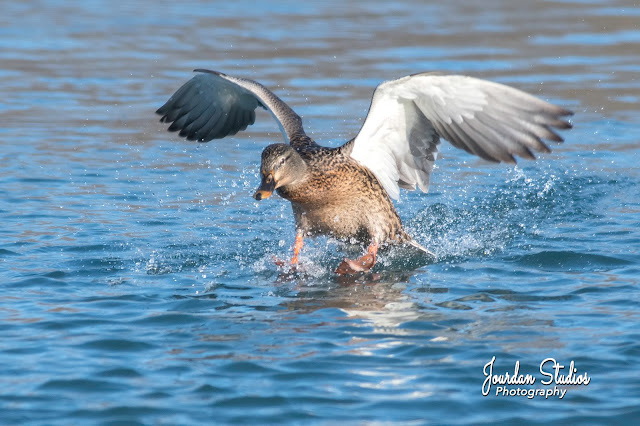Deep-freeze Waterfowling - 05 Jan 2018
I've been having autofocus issues with my Nikon D500 lately. I first noticed it up north in Rudyard when I blew two dozen shots of Sharp-tailed Grouse from inside the car, and couldn't get clean photos of Snowy Owls at Pt. Mouillee. I began to suspect that it might the Group AF function that I have set on the camera. Group AF is great because it uses the middle banks of the focus sensors to help lock focus on a moving subject. The problem is that it always focuses on the nearest-focus object, so if you're photographing a bird in flight it might lose focus on the eye and focus on the wing that is closer to your lens.
When photographing from the car during cold weather, focus can get messed up big time as convection currents can affect focus lock on the subject. That, and even the slightest bit of snowfall can cause Group AF to lock on snowflakes passing in front of the subject, thus messing up focus. I suspect this to be true since the camera works tack sharp when I shoot indoors, or at objects through the window outdoors. So, I switched the camera back to Dynamic Autofocus with 25 points (d25) and gave it a workout the past few days on the Detroit River in Wyandotte.
The bitter cold weather that has gripped Michigan and the rest of the nation was frozen lakes and rivers, thus bringing waterfowl a bit closer to shore. The Detroit River along Wyandotte has been frozen in the middle, and partially open along the near shoreline at the foot of Ecorse Rd. and at the Wyandotte Municipal Boat Launch at St. Johns St.
Day 1 (4 Jan) was a disaster. I couldn't focus on near-swimming ducks with the camera set on Group AF. Canvasbacks and Redheads in flight were all out of focus when I tried to lock on them during light flurries. Attempts to focus on Mute Swans produced OOF captures that were very disappointing.




Wyandotte Boat Launch, Wayne, Michigan, US
Jan 5, 2023 12:00 PM - 12:35 PM
Protocol: Traveling
0.3 mile(s)
Checklist Comments: Cold
8 species
Mute Swan (Cygnus olor) 23
Mallard (Anas platyrhynchos) 6
Canvasback (Aythya valisineria) 12
Redhead (Aythya americana) 12
Common Goldeneye (Bucephala clangula) 2
Common Merganser (Mergus merganser) 2
Ring-billed Gull (Larus delawarensis) 20
Herring Gull (Larus argentatus) 15
View this checklist online at https://ebird.org/checklist/S1
This report was generated automatically by eBird v3 (https://ebird.org/home)
Jan 5, 2023 12:00 PM - 12:35 PM
Protocol: Traveling
0.3 mile(s)
Checklist Comments: Cold
8 species
Mute Swan (Cygnus olor) 23
Mallard (Anas platyrhynchos) 6
Canvasback (Aythya valisineria) 12
Redhead (Aythya americana) 12
Common Goldeneye (Bucephala clangula) 2
Common Merganser (Mergus merganser) 2
Ring-billed Gull (Larus delawarensis) 20
Herring Gull (Larus argentatus) 15
View this checklist online at https://ebird.org/checklist/S1
This report was generated automatically by eBird v3 (https://ebird.org/home)




























Comments
Post a Comment
Please leave a comment. I will try to respond ASAP.